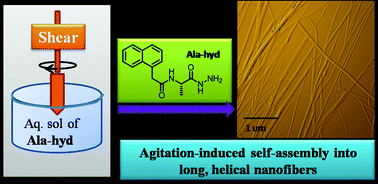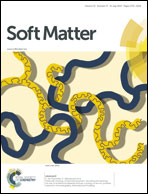Mechano-responsive gelation of water by a short alanine-derivative†
Abstract
We report the design of a structurally concise alanine derivative (Ala-hyd) that has a rotationally flexible aromatic N-protecting group for alanine and a hydrazide functionality at its carboxylic end. Ala-hyd requires mechanical agitation (physically stirring, vortexing or sonicating) to form supramolecular hydrogels at medium concentrations (0.4–0.8 wt%). At higher concentrations (>0.8 wt%), it spontaneously gelates water on undisturbed cooling of the hot solution, while at lower concentrations (<0.4 wt%), only turbid suspensions were formed upon agitation. In the <0.8 wt% regime, hydrogelation by Ala-hyd is modulated by its concentration as well as by the extent of applied mechanical agitation. Turbidimetry and fluorescence spectroscopy indicate enhanced self-assembly of Ala-hyd upon agitation, and FTIR studies point towards stronger hydrogen bonds in the resulting assemblies. Since Ala-hyd requires mechanical agitation to undergo self-assembly, its aqueous sols exhibited mild shear-thickening behaviour in buffered as well as salt-free conditions. During shearing, the formation of an entangled mesh of long, helical nanofibers coincided with the maximum in the bulk shear viscosity. pH-dependent rheological investigations indicate that protonation of the amine unit (pKa = 8.9) of hydrazide diminishes the self-assembly propensity of this compound. The self-assembly of Ala-hyd can thus be modulated through mechanical as well as chemical cues.


 Please wait while we load your content...
Please wait while we load your content...